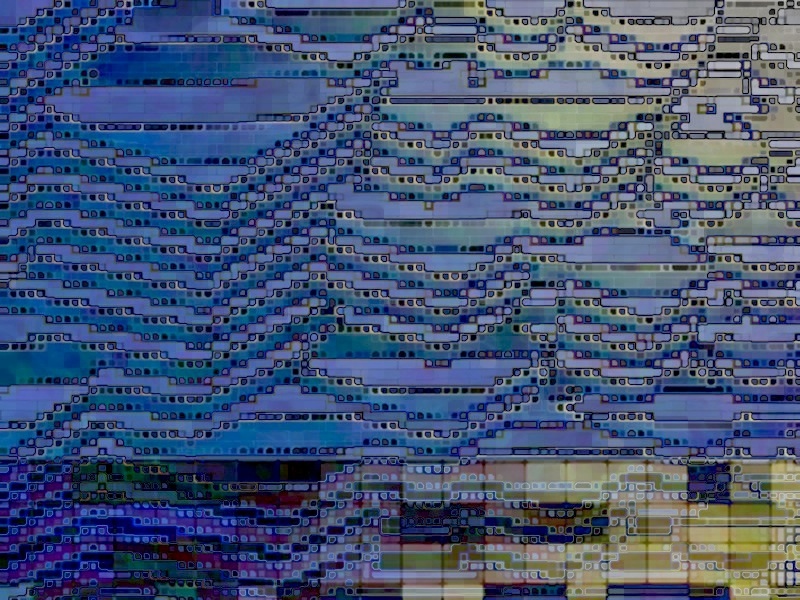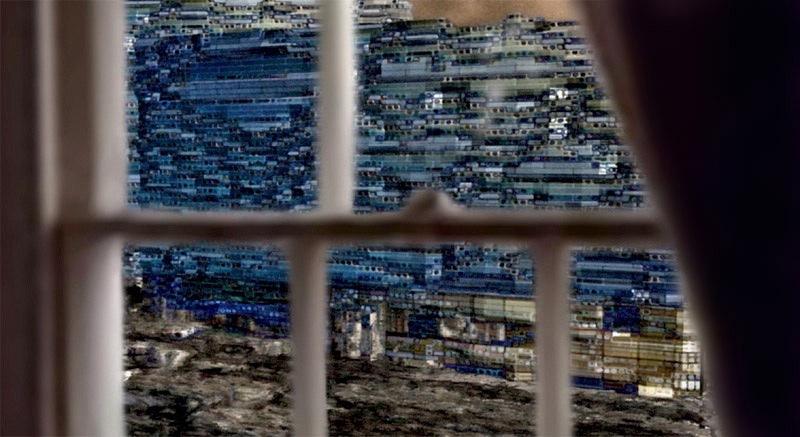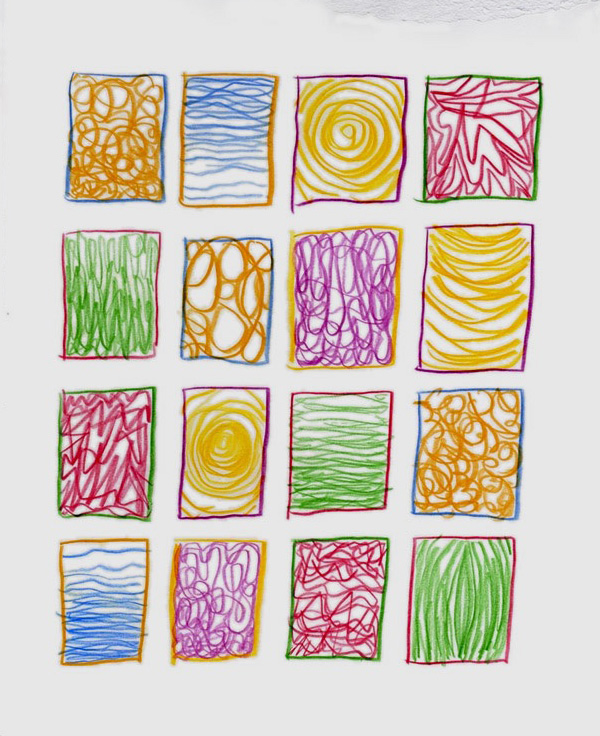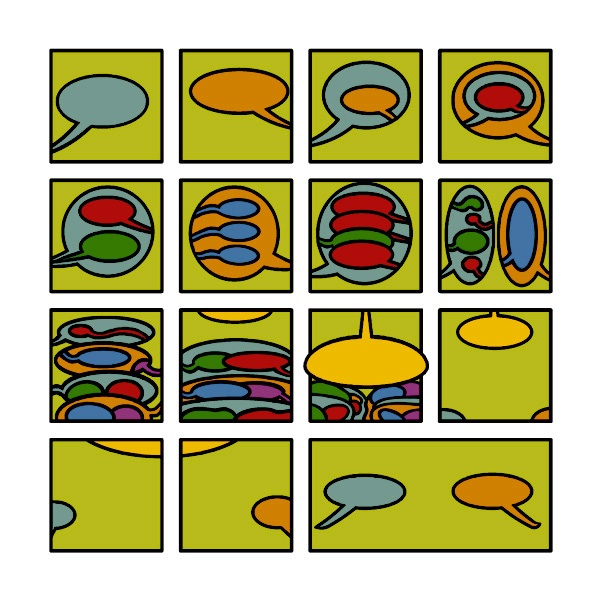Monday, May 25, 2009
Abstract Cartoons: Meta-Toons
I don't have an image of a recent abstract comic, but I thought I'd embed my abstract animated cartoons. This is a series of four abstract cartoons by me (Mark Staff Brandl), originally made in 2001, in collaboration with Mustafa Kocabeyoglu.
Sunday, May 24, 2009
Saturday, May 23, 2009
Abstract 17 Series 3 'Lines' page 6

Abstract 17 page 6 was a 6 page experiement it starts here. I would be interesting in seeing what people have to say about it. I was interested in breaking up and spreading out comic elements over serveral pages.
Drawingsilence.com
A few questions to the abstract comics community
has an essay about the history of abstract comics been written? Has anyone written anything about abstract comics I thought the excerpt from the interview about Gary Panter's 'Zomoid” was fascinating and am keen to read more of this kind of work. Does the anthology contain any essays?
Also, seeing the diversity of abstract comics has been really inspiring!
Also, seeing the diversity of abstract comics has been really inspiring!
Thursday, May 21, 2009
More Dueling

Here's another page I tried out from my earlier idea of taking the fight sequences out of Lone Wolf and Cub and removing the figures.
I'm not sure if this one is as effective since I left the sound effects flashes and the flying stick. Thoughts anyone?
I'm having so much fun with these, I think I'll make a little mini comic of them.
I'll keep you post when I'm finished.
Wednesday, May 20, 2009
art by children



pages by children, from the digital archive of a collection assembled by Rhoda Kellogg:
http://www.scribblings.ch/kellogg/archive/en/query?cat=K&page=123 &
http://www.scribblings.ch/kellogg/archive/en/query?cat=K&page=237
Tuesday, May 19, 2009
The Duel
Monday, May 18, 2009
Lecture


My english is pretty sketchy. Sadly, I can't follow as I would like every discussiona and ideas that are developped here. It all seems very interesting.
I got interested by abstract comics in 1987, after an Art Course at the Université Laval, in Québec. My teachers loved the american conceptual art, and of course abstractness in painting. Comics were rather frowned upon and misunderstood.
It's especially when I read a page by Loulou & Kiki Picasso, in the pages of an issue of the Bazooka magazine, that revolved around experimental comics that I thought I should push things further. The result was the page Parcours, of wich Andreï posted an extract at the beginning of this blog. I was more inclined towards representation in comics, this page was a radical version of what I was usually doing. I hadn't planned on going further in that radical direction, thinking I would continue to develop these ideas within my current works.
For me, this work can be found in most comics authors, who develop it with more or less talent. A few are pristinely aware of that, like Lorenzo Mattotti or Alberto Breccia. (the first has published an important book around the same time as I did this page in '87, the other is an utterly important veteran).
About the Loulou & Kiki Picasso expermiment that I mentionned earlier, I though it was a little cold, although very interesting. In a single page of multiples close up frames, it presented a surgical operation. There was no angle variation, no climax, no suspense.
About the Loulou & Kiki Picasso expermiment that I mentionned earlier, I though it was a little cold, although very interesting. In a single page of multiples close up frames, it presented a surgical operation. There was no angle variation, no climax, no suspense.
It was pretty clear to me that this was abstraction, or at least an attempt at abstraction (from a storytelling viewpoint). A relatively logical progression of action. I thought that, even with those elements removed, something survived, something that's specific to comics. I thought that our medium had to somehow distinguish itself from a series of abstract images, like, let's say Andy Warhols' Marylin faces, that just don't "work" for me as comics. It's a series of images, independant from each other, with no other link than the medium. I don't see it as comics in any other way than something to ponder about.
Comics go futher, or offer something else. It's a system like interdependant words in a text, it involves reading. Again, it can be created with or without talent, with or without awareness. By the way, I really like the coined term Sequential Art. It's really accurate, and a good alternative to comics or BD.
This is what I wanted to exacerbate in Parcours. Working with nothing else than shapes, the subtle ballet of elements. A kind of music.
I'd like to point out some basic notions about comics :
A) A comic panel is read quickly. If I have a big book to read, I don't have the time (or interest, it would be another experience altogether) to decipher each image. It has to be understood pretty instantly to allow fluid reading.
A) A comic panel is read quickly. If I have a big book to read, I don't have the time (or interest, it would be another experience altogether) to decipher each image. It has to be understood pretty instantly to allow fluid reading.
B) Usually, in a panel there is about one or two, or more, center of interests, that the eye will be directed to. In figuration, it can be a face, a fist, anything. In the Parcours extract shown here, it's simply a black dot. One just has to follow it from one panel to the other. It's a place in the image wehere the eye is focalized.
C) From reading each panel is generated what I call a movement effect, in a way similar to animation. With the notable difference that in animation, there is an actual illusion of movement involved that relies on the phenomenon of retinal persistance. Only a certain quantity of images per millisecond can be processed by the retina, resulting in a near-perfect illusion of movement.
C) From reading each panel is generated what I call a movement effect, in a way similar to animation. With the notable difference that in animation, there is an actual illusion of movement involved that relies on the phenomenon of retinal persistance. Only a certain quantity of images per millisecond can be processed by the retina, resulting in a near-perfect illusion of movement.
There. From the skillful (or not) orchestration of these three elements is created a certain rhythm. Music, made of writing and images. Those movements can also be comprised in the same image, as shown above.
It is not necessary to understand the mechanics to produce it (ultimately, understanding it too well can be even an obstacle). This ballet technique can be aquired by simply reading comics regularly like I did from the time I was a little kid.
It is not necessary to understand the mechanics to produce it (ultimately, understanding it too well can be even an obstacle). This ballet technique can be aquired by simply reading comics regularly like I did from the time I was a little kid.
I may read this movement effect in a more acute way than most, but to me, that's what's specific to comics and sequential art.
Happy blog !
Benoit Joly
Further reading:
Feux, by Lorenzo Mattotti
Le coeur révélateur, adapted from a short story by Edgard Allan Poe, by Alberto Breccia.
Le coeur révélateur, adapted from a short story by Edgard Allan Poe, by Alberto Breccia.
Thank to Jimmy Beaulieu for english translation (bj).
bpNichol's mad comics

here's a page by Canadian poet bpNichol, pinched from http://www.bpnichol.ca/media/images/snore_comix_number_two_drawing_bpnichol_5
Sunday, May 17, 2009
Saturday, May 16, 2009
Glitch Comic
I was inspired by this website that purposely corrupts jpg images to create glitch art.
I popped one of my images from a panel that will be in the book and let it go for several derivations.
I pulled them all up in photoshop and played around with the order of them.

Finally, pulled my favorites onto a blank "page" and made this little comic.

I think this would have worked better if I'd had a bigger image, but cool nonetheless.
I popped one of my images from a panel that will be in the book and let it go for several derivations.
I pulled them all up in photoshop and played around with the order of them.

Finally, pulled my favorites onto a blank "page" and made this little comic.

I think this would have worked better if I'd had a bigger image, but cool nonetheless.
Families
Friday, May 15, 2009
Abstract 12b Series 3 ‘Lines’

Abstract 12b Another example from series 3 investigating the gutter of a comic. Sorry about the image not appearing.
Drawingsilence.com
Wednesday, May 13, 2009
sequencing the fuzz of spontaneous moments, stuff vs. stuff, local truths, encoded time, internal histories, the racket the moon makes!
Tuesday, May 12, 2009
abstract art by Tim Gaze
I started this little comic during my after-school comic club. On the way home, I was caught in a torrential downpour that soaked the paper I was drawing on and caused me to quit working on it.
I originally going to riff on this idea for 12 pages or so, but now that I was stopped prematurely, I rather like the simplicity of just 3 pages.



I originally going to riff on this idea for 12 pages or so, but now that I was stopped prematurely, I rather like the simplicity of just 3 pages.



Nina Roos draws beautiful drawings
And some of them clearly veer into abstract comics territory--this one for instance:

ninaroos.wordpress.com

ninaroos.wordpress.com
Sunday, May 10, 2009
1950s Czech abstract animation
Set to Khatchaturian's "Saber Dance" from Gayaneh. As far as I can tell, it's an ad for classical programs on the radio.
(Thanks to Jon Seydl for finding this!)
(Thanks to Jon Seydl for finding this!)
Thursday, May 7, 2009
When are "abstract comics" not abstract comics?
When they're "Abstract Comics Ideas". (See the second session down!)
I suppose it's kind of flattering, really, that people want to jump on the bandwagon even while totally twisting the meaning of the term...
(I'll exclude Scott McCloud from that statement, because clearly he knows what he's talking about. But I'll shake my fists and, looking up at the bird's-eye-view camera, scream in my best Jon Stewart voice: "Kartalopoulooooooooos!!!!")
I suppose it's kind of flattering, really, that people want to jump on the bandwagon even while totally twisting the meaning of the term...
(I'll exclude Scott McCloud from that statement, because clearly he knows what he's talking about. But I'll shake my fists and, looking up at the bird's-eye-view camera, scream in my best Jon Stewart voice: "Kartalopoulooooooooos!!!!")
Wednesday, May 6, 2009
first tries at abstract comics
Here is probably my first try, from fall 2002--ink and white-out on bristol:

That one's been up on blotcomics for a long time. Here, though, are my first attempts at doing abstract comics digitally by remixing one of my own drawings (an approach that has been with me ever since). These are from late 2003. They were done entirely in Microsoft Paint:


The original drawing that I remixed is a page from my mini, "Yam Seal Land."

That one's been up on blotcomics for a long time. Here, though, are my first attempts at doing abstract comics digitally by remixing one of my own drawings (an approach that has been with me ever since). These are from late 2003. They were done entirely in Microsoft Paint:


The original drawing that I remixed is a page from my mini, "Yam Seal Land."
Abstract 8a ‘they are coming’

Abstract 8a A wall of text, an experiment I wanted to see what would happen if I tried using text without its usual partner in comics the word ballon. I what I think is interesting is how this changes how we view how text operates in comics, it is the image. If you're keen there is some interesting discussion in the comments.
Labels:
abstract comics,
Draw,
drawingsilence.com,
panels,
text,
words
Saturday, May 2, 2009
Abstract 11a Series 3 ‘Lines’

Abstract 11a from my third series of Abstract comics. With this series I was interested several things. The process of making Lines on paper, how that relates to reading comics. The way we read comics, how we create narrative. And how panels and gutters interact within a comic.
Drawingsilence.com
Friday, May 1, 2009
Apartcity
This is from May 1999 (ten years gone...)

Yes, I expect you to read each and every one of those little panels!
I made the image in Photoshop by painting on separate layers,
filtering them, trying different opacity settings, then painting some of the details to refine it.
The image above shows how the layers appear when set to 'normal' opacity.
In the file, with the first image on the bottom, the second and third layers are both set to 'difference'.
Next, I made a 3-D model based on the flat image, using a grayscale version of the image as a displacement map (the same way terrain is made - determining the geometric positions of the points by the values of light or dark throughout the map), also using the image as a bump map and the color version as a texture map.
I made a copy of the model and placed it behind and to the left in the scene.
After rendering the models, I added the sky, the dirt road, the window and the curtain.

Making this piece was an attempt to capture a nightmare I had when I lived in New York City
across from a monster apartment building. It turned out pretty accurate.
At the time I made it, my work was featured in a book called Photoshop Collage Techniques.
There was talk of another book on filters but every time I showed examples like this to the author as a possible tutorial feature, he said, "Well, I think that's something only you would want to do."
Subscribe to:
Posts (Atom)

















